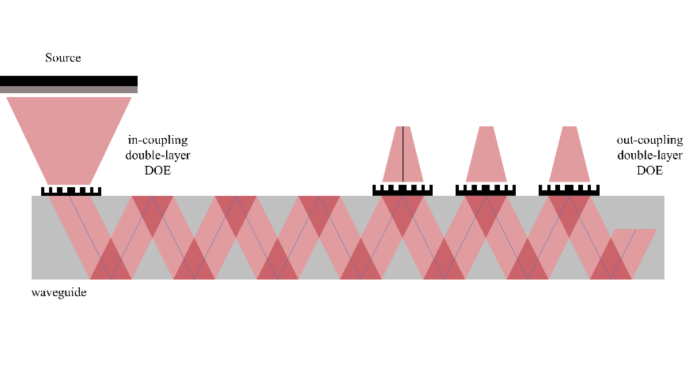Scientists have developed a novel double-layer diffractive waveguide system aimed at advancing imaging technology. This system employs two double-layer diffractive optical elements (DOEs) to efficiently manage light for both input and output, enabling the collimation and reconstruction of the field of view.
The innovative design utilizes a slanted grating structure within the DOEs to maximize diffraction efficiency. Light entering the system is first processed by the in-coupling DOE, which transforms the wavefront to create a plane wave. This plane wave then travels through the waveguide, undergoing total internal reflection at the waveguide boundaries. Subsequently, the out-coupling DOE reverses the process, reshaping the wavefront to reconstruct the original field of view for the viewer.
Researchers explain that this system is particularly suited for micro-display panels like OLEDs, modeling the light source as a two-dimensional array of point sources. For the waveguide itself, a lanthanum dense flint glass was chosen due to its high refractive index. This high index is crucial for achieving the total internal reflection necessary for guiding light within the waveguide, even for longer wavelengths of light.
A key feature highlighted is the system’s potential to achieve a wide field of view, theoretically up to 90° by 90°. This is made possible by modulating optical information into a planar wavefront before it enters the waveguide. Furthermore, the design incorporates ‘pupil duplication’ to extend the exit pupil, which is beneficial for improving the eyebox size – making the viewing experience more comfortable and less sensitive to eye position. This pupil duplication is achieved through a series of total internal reflections, effectively replicating the entrance pupil.
The team has provided detailed calculations and equations outlining the relationships between the system’s parameters, including the grating period, waveguide refractive index, and angles of light propagation. These equations are crucial for optimizing the system’s performance, particularly in terms of uniformity of light intensity across the pupils and overall system efficiency. The goal is to achieve high uniformity and maximize the average efficiency of the double-layer waveguide system.
This research introduces a significant step forward in waveguide technology for imaging applications, potentially paving the way for advancements in areas requiring wide field of view and comfortable viewing experiences, such as augmented reality and virtual reality displays.

Leave a Reply